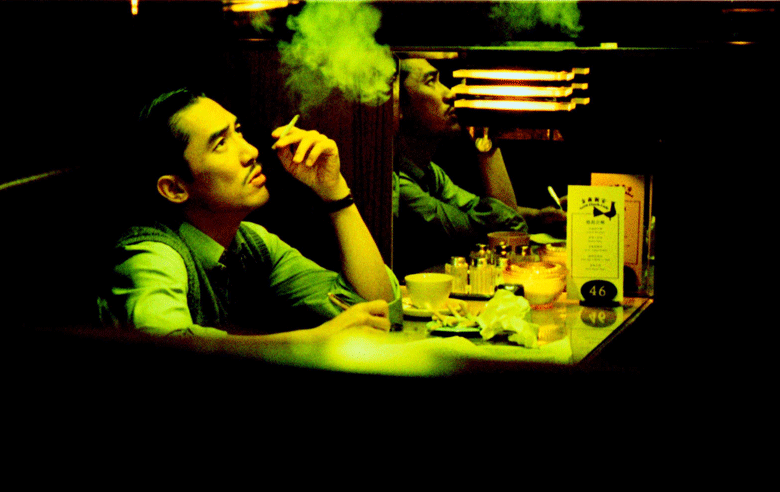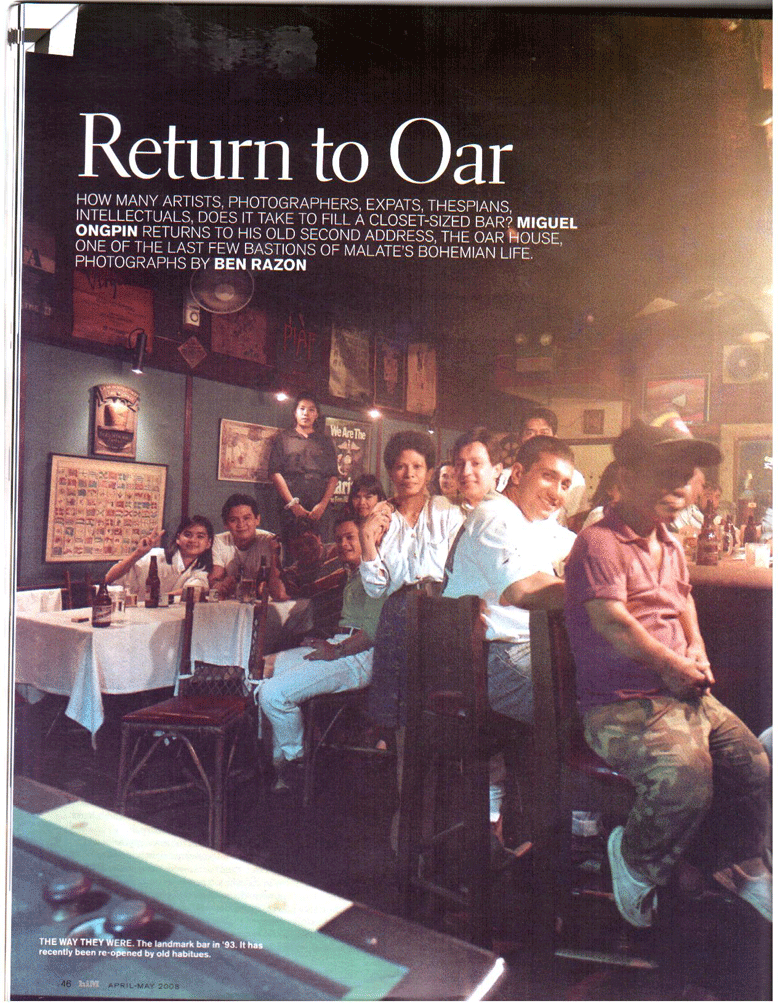
Miguel Ongpin, who is now an editor at the Manila Bulletin, wrote this story for the defunct Metro Him middle of last year. It was our glass-raising gesture to the reopening of Oarhouse, accompanied by vintage photographs from another Oar habitue, the photographer Ben Razon. Tonight, we raise our glasses, bottles, roses, for the last time in this, a place where we met new friends, flirted with boys, hung out with be-scarfed phototojournalists, and took heart that our drinks were being served by a guy who has opened bottles for us for many years. The Oar is dead. Long live Oarhouse.
Oh the fabled Oar House. It is best described in the physical sense as a tiny little wooden bar immediately next to where the legendary Hobbit House once stood. Through the years the Oar House has illuminated itself as a very rare, brilliant little jewel niched in Manila as an imagined port city. I will always remember it as a dim lighted place where myself and many others blindly gravitated toward like moths to a flame seeking cold beer and hopefully quiet and intellectual conversation in an escape from Manila’s deafening and often nonsensical mundane noise.
It’s funny how life is. Recently, I received a text message from a close friend Reg Hernandez; who now runs the Oar House full time, that Australia and Port Barton, Palawan-based painter Diokno Pasilan was at the bar. It was in fact Diokno who first took me to the Oar House in the early days of our poetry-painting collaborative years right at the beginning of the 90’s. Subsequently, much later I would be the first person ever to take Reg into The Oar House. Now he’s there running things every night the place is open. Full Circle. Neat.
Again recently I was at The Oar House nursing a cold pale pilsen in the early morning hours just past midnight when and odd lull in the conversation occurred and I heard Reg ask: “Bakit kaya tinawag na Oar House ito?”
“Hindi mo alam?” I replied.
I began to explain.
It was then that I realized that something that all along had been obvious to me; may not have been obvious to The Oar House’s Manila clientele. During the latter years of my high school in Massachusetts it seems I was recruited for my small stature (small compared to my 6 foot 5 boatmates) as a Coxswain for Varsity Crew’s 2nd Boat(The 1st Varsity Crew boat was steered by a pretty Italian-American girl even smaller than I was in those days.). The role of a Coxswain is the guy who steers the Crew Boat and rhythmically calls out the number of strokes as they row in practice or in a race. So he is not unlike the guy with the big drum in those Dragon Boat races we have here in the Far East. Part of a Coxswain’s duties are to issue the commands of lifting the boat out of the water and setting the delicate wooden hull (or in the modern era now fibreglass) onto it’s rack inside the Boat House…or as Some may term The Oar House (assuming there was a separate one exclusively for the very long oars.) A Coxswain had to issue these commands out loud like a drill-sergeant to ensure everyone acted in unison to prevent the boat from being dropped or damaged.
The Oar House’s footprint is very unusual. The area of the front door is only about four meters wide while the depth of the bar is about twelve meters. It has almost the exact dimensions of a Boat or Oar House. That was what must have been in the mind of retired US Naval Aviator Charles “Chuck” Monroe when he named and opened the place in 1977.
When that happened I was only five years old. So if the History of The Oar House in a timeline can be likened to a basketball game; I came in around the third quarter. That would be 1992.
The physical description of The Oar House is not difficult to remember. The place was built by a ship’s carpenter form Hull, England. It was about soft light and warm wooden hues. An atmosphere not dissimilar from what one would imagine the interior sub-deck quarters of a galleon might look like. There were some surrealistic aspects to the interior. I remember for instance the entire ceiling being draped by a fishnet that gradually gathered soot from the second hand smoke of the bar’s patrons’ cigarettes. Within that blackened space was a warren of strewn objects. I recall a small bouy, a plastic baby infant doll with oddly cherubic features, a fishing rod, dingy paddle, a plastic floating fish pool toy, and other strange objects with arcane nautical connotations.
The wall immediately behind the bar at eye-level had dusty front pages of newspapers from bygone eras beyond my birth date bearing headlines like…”Manila Liberated”…”Marshall Law Declared”…followed by more recent events like…”Marcos Flees”. On the walls were framed posters of productions staged by Repertory Philippines, almost all of them musicals (Given by actor-patrons, no doubt). To the right of the bar were some framed photographs taken by photojournalist friends of the resident bartender of my time, Chino Medina. One depicted Nur Misuari’s son with an M-16 equipped with an M203 rifle grenade launcher that had a extreme-modified banana clip magazine that held fifty rounds. Another had a fellow biting the sides of a pineapple-type hand grenade. Other photographs appeared to depict government troops aboard small flat-bed trucks driving into market areas of conflict-torn towns in what appeared to be Mindanao.
“Parang babaeng may amoy na hindi maintindihan.”-Pinikpikan founding member percussionist and IT professional, Butch Aldana
The Spiritual Dimesions or “The Vibe” of The Oar House is far, far more difficult to ascertain. It is maddeningly confusing. It is not unlike a modern-day Filipino trying to make sense of say… ”British (or even recently Italian) Football Hooliganism, Cricket (You know that weird Anglo game nobody here understands?) Fanaticism in India (Death Threats aimed at the National Team that lost), Neo-Nazism in Russia (Didn’t these guys fight a World War against the Nazis?), and say…Berlin’s Annual Love Parade.
You kind of had to have been there. To understand.
The Oar House is hard to understand. When I first saw it I never knew a bar could be so small. It was more like someone’s walk-in closet fitted with a wooden bar, a tiny bumper-pool table, a minute bathroom, and a few small tables. Many things about The Oar House are difficult to comprehend. A German Chef friend used to regularly hide in the bathroom following a bust-up in any one of the Honky-Tonk bars of the Pre-(Fred)Lim era. I worked with Felipe “Jun” Medina for 8 months before I figured out he was Chino’s father.
It was a psycho-spiritual Tribal Thing. Long before the advent of the internet, the film The Beach, and budget airlines The Oar House functioned like a Trading Post of sorts. Postcards and letters came in from all over the world; some waiting for foreigners living in “Far Out” rural areas to make their occasional, necessary trip to Manila and The Oar House to receive their mail. There were various cliques that often frequented The Oar House, the local neighborhood residents (many from surrounding apartments), the thespians form Repertory Philippines, various members of the Philippine Media, Artists, Writers, Sagadans and Sagadaphiles, and Strange Foreigners of all types; the Peace Corps, US Manila Embassy Staff (“The Spookies”), French Aid Workers, and global backpackers.
Commonalties in this instance are hard to identify. But let me shed light on one very obvious thing.
Sadly, the very European concept of “The Pub” is lost on the majority of Filipinos. A good pub is not about having fake antiques, Irish cultural reference icons, scripted service bartender-waiter pick-up lines, and the Super-Sized portions of menu items.
It’s more about knowing what the client drinks, making them feel genuinely carefree and at home; and hell, maybe the occasional free drink.
Older people have often been asked “Where were you when President Kennedy was shot?” or more recently many others have been asked. “Where were you when 9-11 happened?”
I was a Fly-On-The-Wall that accursed night when the Infamous Oar House Bust Up occurred…and event that ultimately caused the demise of The Oar House’s Medina Era. It was the beginning of the end of one Truly Good Thing. It was utter chaos. I did not and could not understand what was happening. Two guys came in and beat up Chino and his friend Lyle and busted the place up. One guy was a Fil-Am more than six feet tall. I wanted it all to stop. I wanted to intervene. I didn’t want this to happen. But it wasn’t my fight and I had no idea whatsoever of what was going on. Even now looking back I would certainly have been beaten up very badly if I got involved. That night I had to drive Lyle to the hospital to get his eyelid stitched up.
Gone was the Good Time. I remember those tender early pre-dawn hours of an unimaginably blissful moments of quiet conversations with Chino, “Manong”, and a few others and then being greeted moments later by the stark callousness of Manila’s after-midnight traffic bustle on Mabini Street once I exited the front door to hail a taxi.
The Oar House then entered The Undead Period; a kind of Dark Age period in the bar’s history. The Medinas had left the place and The Oar House had “Gone Bamboo”. Anything related to wood and true character was viciously ripped out in a tasteless and atrocious aesthetic crime. The place resembled a 24-hour roadside cigarette/betel nut kiosk in Taiwan. The name was changed to The Ore House. Die-Hard characters led by the likes photographers Ben Razon, Mon Acasio, The Sepe Brothers, Tim Alipalo, and Derek Soriano and a few other stubborn stragglers still showed up in beer-fueled denial. For the memory of what the place used to be.
Many people with related sympathies as the aforementioned would years later lose the legendary Jesus Armas of Casa Armas fame. He was a generous man and an eternal friend to many. But to people like myself and the mentioned extended clique; we are in an emotional denial of Jesus’ and The Old Oar House’s absence. We consciously know they physically are gone…but they continue to live in our hearts every day.
When the abhorrent Ore House closed doors The Oar House Location suffered further insult to injury and became a roast duck restaurant with headache-inducing pink flourescent lights.
“Oo nga e maraming dumarating dito na naghahanap ng beer,” the then proprietor told me.
Until finally even that closed; and The Oar House was just gone.
A few years back logistics expert Nonoy Tan endeavoured the heroic and reopened The Oar House. It half-worked for a while but time would prove that the place hungered for full-time attention. Eventually this is where Reg Hernandez and Redgie Cinco came in. At the start of the year these two veterans of years of running bars took over The Oar House and now steer the place the way it was meant to be; by people with heart and soul who were once patrons.
Printed with permission from the writer.
...Read more
Wednesday, December 30, 2009
IN MEMORY OF OAR ] Miguel Ongpin writes about what was once a second home
Tuesday, December 29, 2009
REMEMBERING COCO BANANA ] As we say goodbye to Malate as we know it
 Madame Coco.A page from Metro Society shows Ernest Santiago standing guard by the entrance of his legendary club.
Madame Coco.A page from Metro Society shows Ernest Santiago standing guard by the entrance of his legendary club.
In light of the news that the two remaining bastions of Malate's bohemian nightlife, Penguin and Oarhouse, has announced its last calls--forever--we look back at the club that defined Manila nightlife in the '70s, Coco Banana, whose createur Ernest Santiago died two years ago this month.
To hear its devotees describe it, the look of the place fails to evoke the fabled long nights and decadent parties that made it a legend. The vignettes its habitués remember comprise an old house rustic in appearance, Machuka tile flooring retained from the original structure, bleachers made of wooden planks surrounding the dance floor, the bar at the right, and the metal and glass door entrance.
How these become by nighttime Coco Banana, the most fabulous club in the history of Manila nightlife, is a transformation born out of the virtuoso hand of Manila’s Steve Rubell, Ernest Santiago, and the cast of characters he assembles every night. “You can’t be too straight or square if you want to be at Coco. Even society people—they have to be a little mad to dare enter,” remembers a former Malate club owner. But the people alone didn’t account for each evening’s high spirits: there were the music, the drinks and the drugs.
The club was born in the era of disco and Donna Summer and, cliché as it may sound, the days of sex, drugs and rock and roll. “It was the first openly gay club in Asia,” says Louie Cruz who can’t remember if he was already wearing his off-the-shoulder blouses then. “But it was not just a gay ghetto,” offers Ricky Toledo, who started frequenting Coco as a student in Ateneo. It was the club to see and be seen, and during the Martial Law years, everyone’s fun, glamorous jailhouse of choice if you want to avoid the PC.
The place never announced its exact address. “The world knows where we are,” its tagline said. And it seemed, in its twelve-year run (it opened June 12, 1976), Manila’s nocturnal creatures knew exactly where to go when they wanted to party like it’s 1979: that old house-turned-hedonist mecca along Remedios Street, three houses from the corner where the atelier of designer Mike dela Rosa now stands. One would think the owner could have printed its location on the souvenir matchstick pads scattered at the bar. Those pads, it turned out, proved handy and popular for jotting down the name and number of one’s catch for the night.
The club was created by Santiago, a designer by day who, bored by the dreary Manila nightlife and with P25,000 to spare, decided to open Coco “para may mapuntahan naman ang mga bakla.” He was a lean butch-looking fella with jet-black shoulder-length hair who could be wearing something fabulous of his own creation (a white denim trench coat perhaps, sprinkled with rhinestones) or something that enhances his gym bunny reputation (military pants with a metal-studded belt, a cut-off shirt and a pair of leather boots).
'You can’t be too straight or square if you want to be at Coco. Even society people—they have to be a little mad to dare enter'
Then in his 30s, Santiago was the club’s proprietor, creative director, Mother Superior, and door bitch. By 9pm at the entrance, he would look members of the queue head to toe and decide if one would be let in or be told to go home and dress up (most of those declined actually go home and dress up; those who don’t follow a party’s costume theme is ‘quarantined’ for an hour and a half at the holding area before they could join the party). Those whose "vibes" he simply didn’t like were told the place was full. He wasn’t called ‘tarurit’ (or mataray) for nothing. “He was a force to reckon with,” says Chito Vijandre, who once won a trip to Paris for showing up as the lion in The Wiz. “He had the most piercing eyes,” he says of Santiago.
Weeding out the undesirables at the entrance allows Ernest to create the potent cocktail of a party crowd the club was famous for: a mix of artists, drag queens, diplomats, journalists, show biz celebrities and members of Manila’s 400. For Santiago, it is always about the mix—and the liberating feeling of being in a huge crowd packed in a small place, with the collision of everyone’s breath, sweat, perfume and smoke just adding to the dizzying effect of one’s tall drink or downer of preference.
The dance hall itself was a dimly lit place, with only a few pin lights landing on guests’s faces, “so that everyone gravitates to the dance floor like an enigma,” Santiago says with theatrical hands. A spotlight quickly locates a new guest’s arrival each time the door opens “so that everyone feels like a star.” On special evenings, a significant portion of Remedios will be closed and a red carpet rolled out for Coco’s guests—velvet ropes, spotlights and all.
Whenever a foreign celebrity arrived in town, there was a big chance he or she will be at Coco. At any given night, one can meet a royalty from Europe, a baron, a vicomte (if one is lucky, even get to go back with said royalty to his hotel). It was a melting pot of nationalities. For young men like Toledo, Coco was “a lesson in international relations. What they don’t teach you in school, you learn at Coco.”
During the Marcos years, Santiago’s flair for entertaining was so renown Malacanang would often call on his services to take care of its VIP guests. Champagne, needless to say, flowed like water in the club on those occasions. Once, he got a call from Francis Ford Coppola asking if he could accommodate cast members of the Apocalypse which was then filming in the Philippines. Celebrities from Sean Connery to the Village People have partied at Coco. Felipe Rose, that American-Indian-attired Villager, loved Coco so much he stayed on in Manila after the rest of his group had left. He even found himself a boyfriend. When Linda Carter, Wonder Woman, landed on the cover of Time Magazine, she wore a Coco Banana shirt bought from the club’s souvenir shop.
You want a tablet of Q, Louie Cruz will gladly put one on your tongue--but he wants to see you swallow it. 'Because he might want to take it in his own time, but you’re there to get high sabay.'
The popularity of Coco was such that it was immortalized in a popular Hotdogs song which became a Nora Aunor movie (Annie Batungbakal). The same song made a household name of hairstylist Budji Layug, more famous then as Budjiwara or Budji for short (“Buhok mo’y Budji, talampaka’y Gucci”), one of a batch of fabulous young men—which included Louie Cruz, Ron Gomez and Ruben Nazareth—who made Coco their second home, fresh from their training under Vidal Sassoon in London.
There was a lot to love about Coco. For the entrance fee that began at five pesos (which reached P150 before it closed), one is assured of an elaborate visual treat beginning with Santiago’s lighting effects and a show featuring gay performers. James Cooper as Diana Ross was a star and so was a group called Coquettes who performed musical reviews. The club’s excellent production of West Side Story ran for eight weeks, prompting the CCP to write a review in its gazette. Then there was the dance music—the latest from underground cult clubs in New York. The swing was at its peak. Gloria Gaynor. Alicia Bridges. Yvonne Elliman. “People really get up and dance like it was a show,” recalls Vijandre.
And everyone brought their baon because Santiago prohibited any drug-dealing in the club. The drugs of choices were Quaaludes (called “Q”) or Mandrax (then “ekis), and the occasional cocaine. You want a tablet of Q, Louie Cruz will gladly put one on your tongue--but he wants to see you swallow it. “Because he might want to take it in his own time, but you’re there to get high sabay.”
Drugs were so commonplace that an accidental dropping of a tablet will cause a mild commotion—everyone will start searching the floor to snatch it. Otherwise, Cruz jests, it was a welcome idea to vacuum-lick the floor.
The ekis action would reach its peak at The Rocky Horror Picture Show productions. Santiago played Mr. Frank-N-Furter, the mad scientist slash transvestite at the center of the ‘70s musical on sexual confusion and ambiguous morality. “Everyone was already drugged when the show starts,” says Vijandre. “And that’s the only way one would understand that show!”
Most nights, guests would pass out wasted on the cushioned bleachers, from which they will be carted off by their drivers who would knock on Coco’s doors come four in the morning ready to retrieve their senyoras.
“Walang away-away no’n,” Santiago recalls, “Everyone was kalmado, parang nakatingin lang sa langit lahat.”
Although there were mild catfights here and there, the one memorable eksena took place one Saturday night between a pair of very prominent, very rich lesbian lovers—and a Bvlgari necklace. As soon as lesbian#1 found out lesbian#2 was at Coco with a date, #1 approached #2, and dragged her out of the club by her Bvlgari. And because #1 refused to contain her rage, she slammed one of Coco’s lights with the necklace. The scene lasted a whole ten minutes--afterwhich everyone went about dancing again as if nothing happened--but Manila society talked about the Bvlgari incident for weeks.
And then there will be another Santiago gimmick to talk about: an Orientalia party, a L’Uomo Vogue-inspired night of all white and mirrors all over. “Parang Midsummer Night’s Dream araw-araw,” describes a regular. From nowhere, muscled men were carrying a Cleopatra-wannabe to the dance hall. One time, Santiago rented the little people from neighbor Hobbit House so that he entered the party escorted by a throng of elves. Once there were mannequins everywhere painted with street graffiti, or an ukay-ukay theme, with vintage clothes that hung from a number of suspended copper wires. A favorite of the gay men were the horses at the Carousel-themed parties. “They will sit on the horses holding their drinks. It was a great place for vogue-ing. And cruising,” says Toledo, who once appeared at Coco wearing a Roman toga and sandals, holding a party mask with its replica painted on his face.
“Everything was done in good taste,” says Santiago, “wild but in good taste.” Not surprising since it was the favorite hangout of the style and fashion set, from designers like Inno Sotto, Rusty Lopez and Romulo Estrada, to top models like Anna Bayle, and fashion patrons like Chito Madrigal. One could watch Chona Kasten or Mary Prieto all night just being themselves, keeping their poise no matter the number of drinks. Once, socialite Cristina Valdez showed up in Eliza Doolitle’s Ascot garb complete with parasol. Designer Larry Leviste walked in as a bum-revealing net-stockinged showgirl. Joe Salazar won a prize for his stylized Ibong Adarna costume: a bodysuit with feathers, sequins and mirror chips. Helena Guerrero of Azabache fame stole one evening when she came in full geisha regalia.
Much as there was always someone to look at, there was always something to turn one’s gaze above eye level—-a huge jar with an outrageous, larger-than-life flower arrangement perhaps. Santiago has a reason for this: when the eyes are looking up, they are strained to become bigger. And big spotlight eyes were all the rage in those days.
At one point in the evening, just when everyone is in the highest spirits, say when Diana Ross is on the last notes of “I’m Coming Out,” a wave of Santiago’s hand would bring the music to a halt and a collective “Awwwww” and whistles will be heard from the crowd. Barbra Streisand and Donna Summer’s “No More Tears” would come in past 4am, a signal from Santiago that says, ‘no more partying, enough is enough.” Most nights, guests would pass out wasted on the cushioned bleachers, from which they will be carted off by their drivers who would knock on Coco’s doors come four in the morning ready to retrieve their senyoras.
But nobody it seemed wanted to leave Coco Banana. At six in the morning, one could still hear glasses tinkling inside.
Even in the last days of disco, the club’s loyalists continued to want more.
In 1988, however, Santiago thought the club has had its time. Vijandre recalls the tears during that last big party. And everyone made sure they partied and got wasted as if doomsday was but a few hours away. Nobody remembers what exactly happened the night of the last big Coco shebang--and with the club's reputation, that's totally understandable. In fact, Santiago recalls no such party. In his mind, he gave no announcement of Coco’s closing. If his memory serves, he got up one morning and locked the place forever.
--Jerome Gomez
This story appeared in the May 2007 issue of Metro Society.
Thursday, December 24, 2009
CD PAINTS, JUAN SHOOTS ] The FINAL last art post for the year
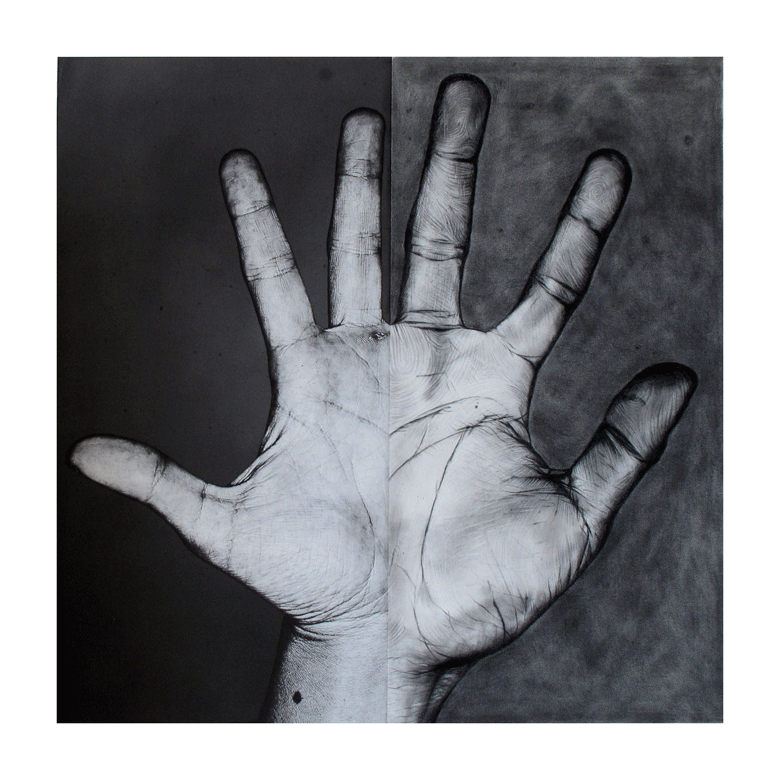
I know I said two posts ago that that was my last art post for the year. But how can I refuse this? Talk about art imitating, well, ME. Kidding. Painter Christina Dy and photographer Juan Caguicla stir the idea of the diptych a little in their January 2010 show at Silverlens (opens on the 13th). "The STEREO I series is a collaboration between me and photographer Juan Caguicla," says CD (she's the one artist who gets away with being called by her initials). "He photographed me (so that's my hand there on the left side) and I drew him (that's his hand on the right), and we put our works together to make up two sides of an altogether new thing." Guess which is whose.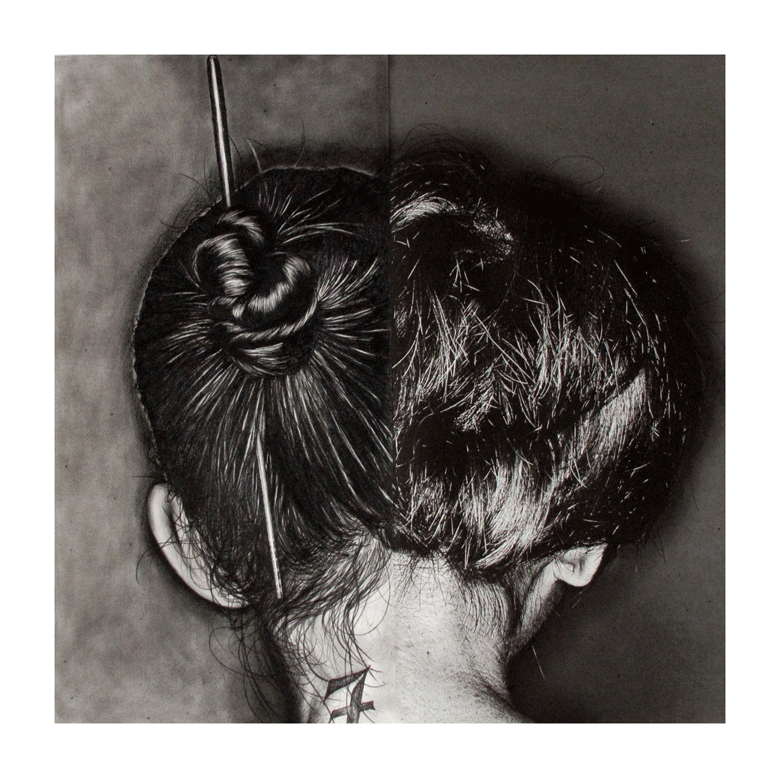
Monday, December 21, 2009
NOUVELLE FICTION ] Ricky Torre imagines a page from the diary of Chow Mo-Wan
I CAN’T recall the name of that pension house, tucked in that hidden corner we wandered into one evening from our strolling along Remedios. But the address of our room—No. 12—yes, I remember that one, framed as it is now in my head, much like 2046, that other room number in my story over which you were once filled with jealousy, Madame Doinel.
Room No. 12. You didn’t even own that room. Remember when we first set foot in that alcove? We paused at the landing after we walked up those narrow three flights and you were à bout de souffle, more it seemed out of anticipation, as your eyes flashed at me their blue. I remember every detail, to borrow Bogie’s phrase to Ingrid—despite my heart pounding like cannon fire, to paraphrase Ingrid. Despite being beside myself. Inside our room you went mugging before the octagonal bathroom mirror, then you counted with your fingers the number of men you slept with in your dreams. The handkerchief you liked to tie into a loose ribbon around your neck I cannot forget also. And your sleeveless blouse, baring the wide smooth plain of your arms. You turned to me, your delicate hand on the doorway, and I asked the question that was supposed to come from you—“Why do you keep looking at me?”—because you preferred to be the one answering, “Because I am.”
You became Jean and Jean-Paul even before that moment, Christine. They were refracted into the prism of your individuality. You became a composite, which is what are all lovers. “Pas mal, no?” went your typical remark.
We lay in bed close to each other, denting the sheets with its pattern of dots and loops. Pliable like fashion models, for we both looked absurd in our stylish clothes were it not for your naked arms. “My accent,” you once said of that detail. I gave in to the impulse to stroke them, as you went on staring at the panel on your side of the bed that needed a paint job. “Is it that Madame Su still enters your mind?” you asked finally, without warning.
“Ooh la la!” I said startled. “I tell you about her only once and she sticks with you. I was never bothered by your stories about your childish Antoine.”
“Ha ya, maybe because I’m not that special to you.”
I thought of leaning over to see your expression but you turned around to face me with a bold smile that contradicted your doubt.
“We look at each other in the eye and it’s no use,” you said to me, still smiling.
“Écoute, Madame C.D.,” I said in a dull voice, without a hint of exasperation. “We’re both fictional characters, as you know. My creator idolizes your maker. But somehow that has not led us to being wrapped in each other’s arms.”
“Or maybe exploring each other!” you replied in your radiant staccato. “Which is what would have happened even if I really don’t belong to my creator’s movement because he drew me up during that period of formalism that became his pattern after deriding it a lot when he was still a critic. Est-ce que tu me comprends?”
It took a world of a second for me to understand you. I was listening more to your voice.
“Well, you struck out on your own anyhow, Madame. I keep reminding myself of your stories about your wondering around Montparnasse like a lost prostitute, as you put it. That wasn’t even like you, unlike my loitering on Lan Kwai Fong.”
“And now we’re here, Monsieur. Your maker’s dream place, if I’m correct. Mine had never even heard of this city.”
The Paris of Asia at that, a title this city had aspired to on the cusp of revolution. That was two centuries away—from the concrete slab fractured everywhere that it is now.
“This isn’t at all what our makers had planned.”
“We’re both here,” I said, as I cupped my hand on your cheek, “but there’s a plot point missing. That’s why we haven’t gone further. Do I make myself clear?”
“No,” you said softly.
“You like it when I needlessly explain things, don’t you?”
“Oui.”

“YOU’RE WRONG about one thing,” you said in hindsight as we walked down the small steps to the ground floor. “We did wrap ourselves in each other’s arms.”
“Oui,” I said. “Wei?”
“Écoute, Monsieur Chow, we didn’t see each other for cute talk. ‘I wanted to see you, to see if I wanted to see you,’ or something like that. I won’t have any of that.”
“How about, ‘Is it that you like my eyes, my mouth or my shoulders?’”
“Comme ça.”
On that note, I kissed you suddenly. We could have missed a step, but, to my surprise, you reciprocated almost with impatience, before we settled into this languid wavelength, like when you take your time nibbling at your favorite petit four.
“C’est formidable!”—at last, your other trade(re)mark.
Then you gave out that throaty laughter you were never embarrassed of. “Monsieur, don’t ever do that again,” you said, laughing still, amid the ruckus of mahjong tiles at the ground floor, the happy cursing that filled the hall and the nicotine tainting the air. At the foyer there was a young couple nursing their beer. I stepped out of the building to light a cigarette and behold my solitude—for I was back on earth, in vain trying to remember the empress dethroned by you.
"From the Diary of Chow Mo Wan" is the second of our two-part tribute to the 50 years of New Wave cinema.
Sunday, December 20, 2009
SATURDAY FUN MACHINE ] Eleven shows, seven spaces, one Sabado
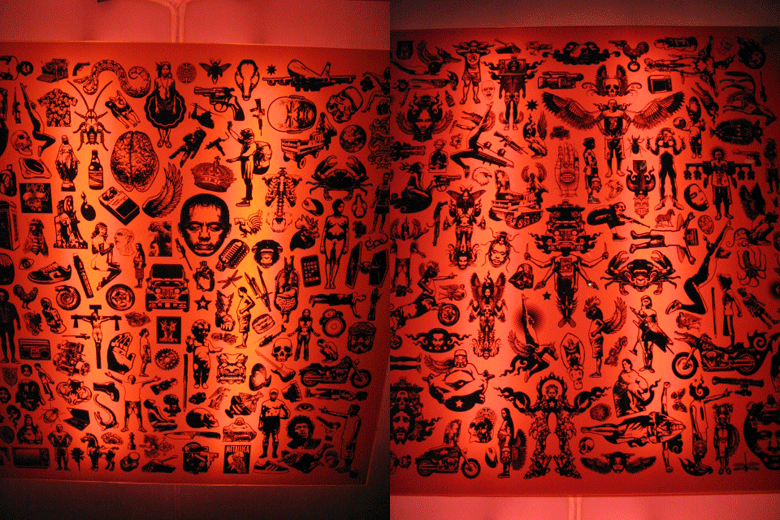
I did a quick tour of the shows last Saturday and saw 11 shows in one day--with an opening right smack in the middle--can you believe it? Of course, you can. I began at the Drawing Room just to take pictures of Kawayan's show (I had seen it two Saturdays ago), and then made my way to Finale where Liv and M.M. are having their solo exhibitions at the Tall and Upstairs Gallery, respectively, and where there was a group show at the Video Room called Saturday Fun Machine. I took the jeep towards the other side of Pasong Tamo and snuck into Manila Contemporary where there was this Tutok SoENA going on, a group show with perhaps a hundred artists whose works were somehow discussing the state of Philippine education. I'm not a fan of themes, or a fan of "art for social change" but from among the plethora of works (arranged like there was some school art contest), we like Wesley Valenzuela's lightbox above.
Just a few steps away, there was the Silverlens group of galleries. There was a film showing of some Werner Herzog film at Slab in the same space where GRP's boat sits. Luis Lorenzana's googly-eyed people are sleepless at 20square, and over at the main space, Silverlens, is the Singapore International Photography Festival where, apart from the works by Vee Speers, we like the works of Luiz Gonzales Palma, an Argentinian who, through his cinematic photographs, reinterprets the myth of the Anunciation.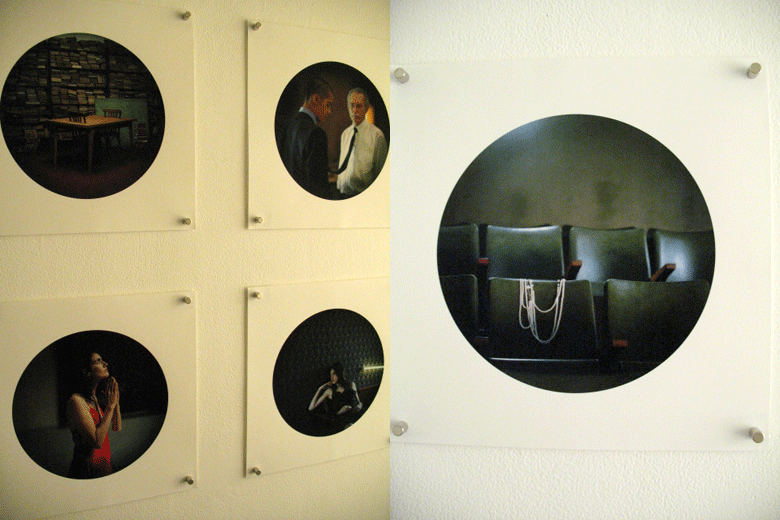
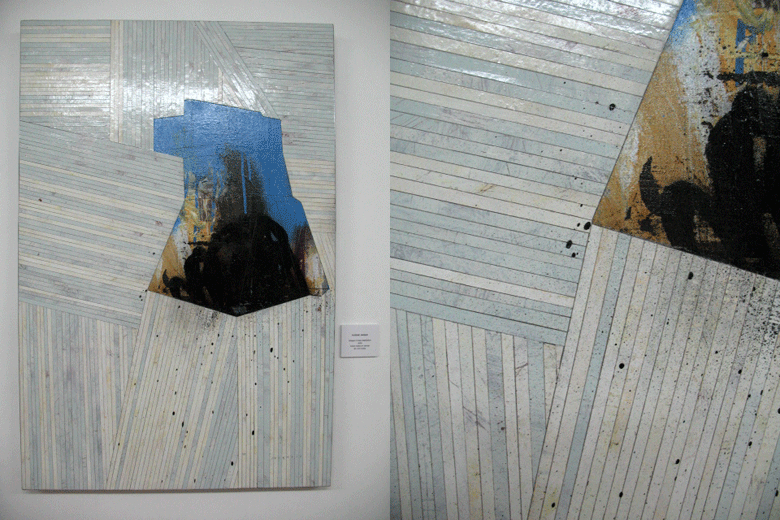
At the Saturday Fun Machine show, which I saw very quickly when it opened a few days back, my favorite is this piece by Eugene Jarque.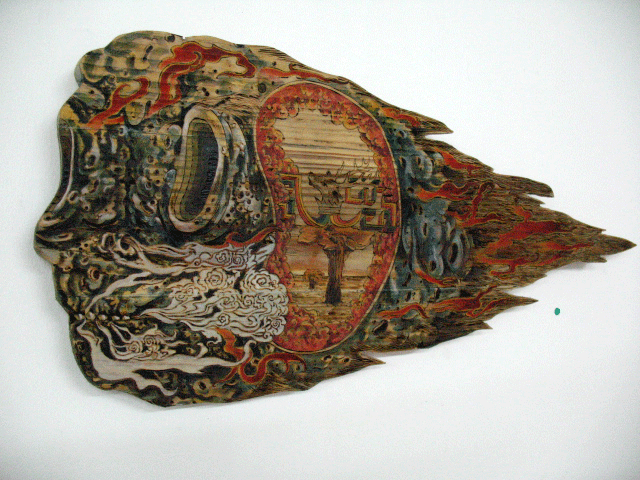
And my friends' favorite was Mariano Ching's (pyrograph and acrylic on wood).
And the coolest is Louie Cordero's video work of clips from unidentified Pinoy B movies in which he super-imposed Nardong Tae-style animation.
"Saturday Fun Machine was a run of cartoon and cartoon related shows on Saturday during the 80’s. This was the time before Disney Channel and Cartoon Network, Internet and DVD. This was a much awaited day for a generation of children as this was the only time that shows geared for this age group was shown the whole morning. Saturday was also the time to peruse our comics from Archie to Zuma and for a generation of youth that would grow up to be visual artists, it was a time to draw and dream. This exhibit features artists that grew up in that generation and the generations that came after it that were greatly influenced by comics and cartoons in their art making process." Or so says the show's accompanying text.
The night we were at Finale for the opening, somebody has brought up the Green Papaya show that opened the Saturday of the Syquia bloc party. We heard our friend Paul Mondok did quite a stunt. In the group show Serial Killers, his contribution was you might call an art-slash-prank: water leaked from the second floor of Green Papaya creating a puddle on the ground floor exhibit area, and threatening to soak some of the works on display. Paul punched a small hole on the wooden floor and put a pail of water that caused the dripping. Donna so loved the work she wanted to buy it. The idea as piece of art, I guess. But what of its resale value?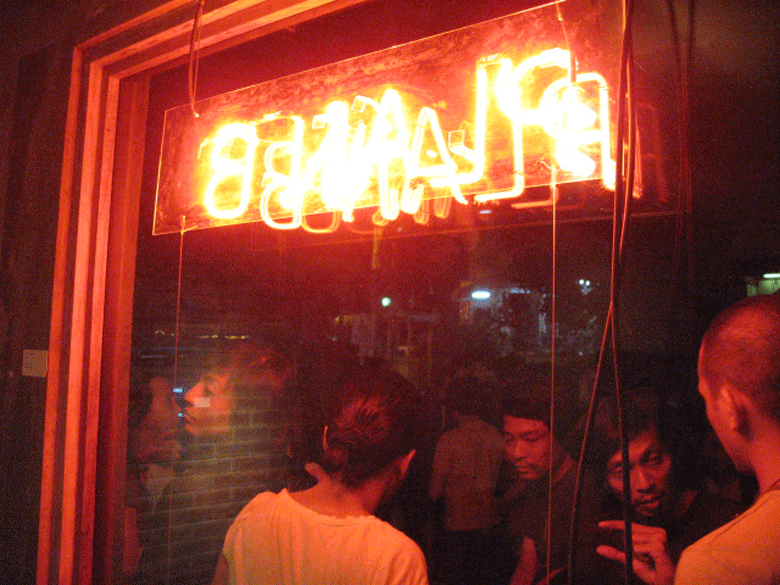
The evening I saw the show, there were musical performances. That's the No To Hangover! crowd that night outside Papaya, lit by Chabet's "Plan B," his contribution to the group show.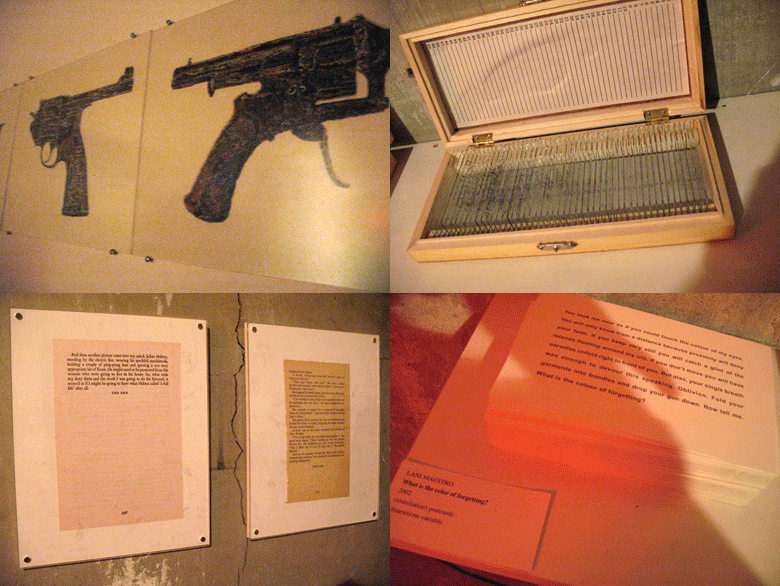
Clockwise from topmost left: works from Gail and Marija Vicente; MM Yu; Lani Maestro; and Ringo Bonoan. Maestro asks "What is the color of forgetting?;" and Ringgo framed the last pages of five or six novels.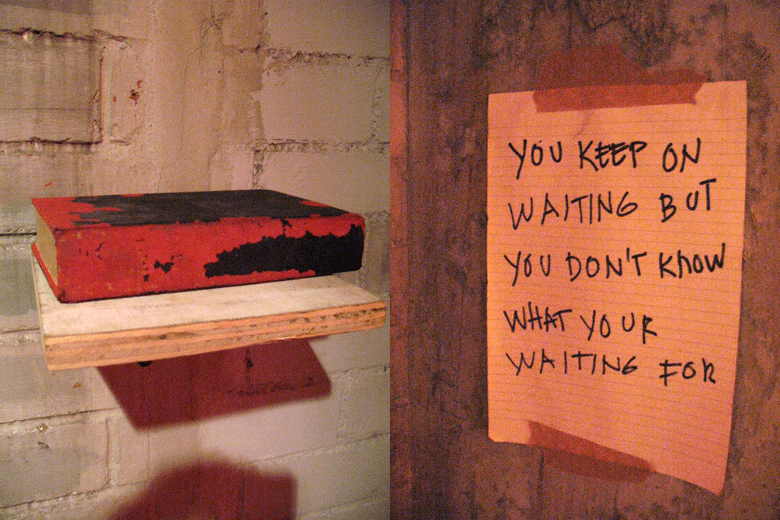
Gary Ross Pastrana's old books; and a sign by the door. I'm not quite sure if that note is part of the show but it seemed like it was when, for awhile, a beautiful, smoky-eyed babe sat below it, slumped on the floor, her back to the wall, a San Miguel Pale in hand. She mostly kept to herself that night, her eyes transfixed at some place other than what was in front of her.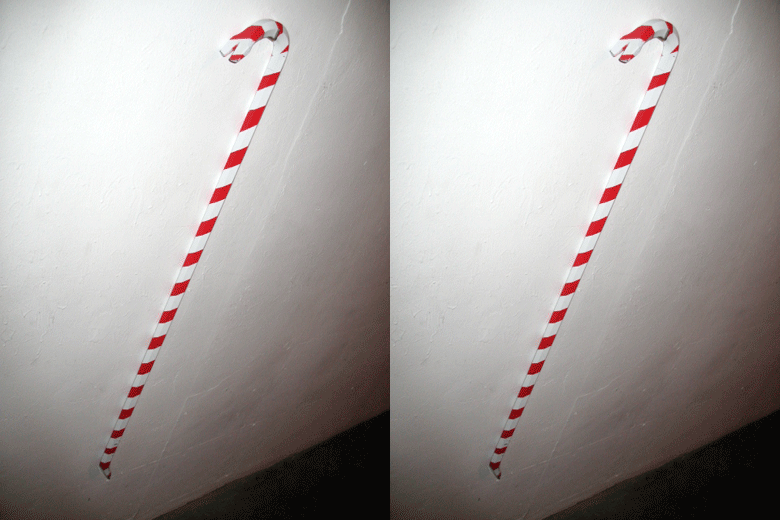
That Saturday we also show Reg Yuson's show at Mos, swung by the new space of Charlie Cojuangco called NOVA at the La Fuerza compound, and was even at the opening of a group show participated in by Popo San Pascual at Le Souffle. This should be the last art post for the year. I don't think there will be shows opening from now until January 1. Although Blanc might still spring a surprise. Hehe. I have no idea how many shows I went to this year. To be sure there was some pretty good work, and lots of the same-old-same-old, and lots of really cute stuff. We've made this observation before, about the popularity of cartoony images in contemporary art, this clearly contagious fascination for cute, and it is being echoed by the Vanity Fair essay on the "tsunami of cute" in its December 2009 issue--although its context is American popular culture. We like cute, with or without the irony. But we like to take our cute with a bit of edge. Just like the Christmas greeting above from Jason Oliveria, a candycane fashioned from a crowbar. 'Happy holidays,' it sweetly greets us, 'and keep your eye out for what just might break your back.'
THE NEW WAVE AT 50 ] Ricky Torre + Dodo Dayao pay homage to film's most stylish movement
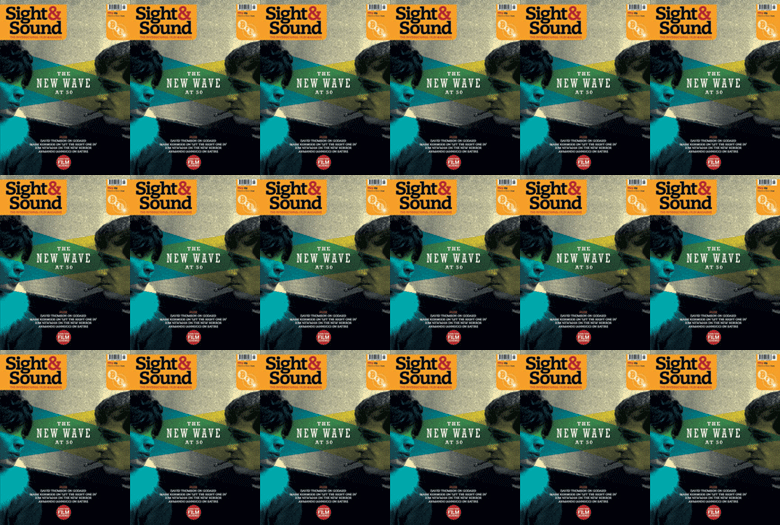
Before this year ends, we add our voice to the 50th-anniversary celebration of the French Nouvelle Vague, arguably the most stylish movement in all of cinema history. We won’t be so presumptuous as to say this movement is the greatest because there is still its dynamic precursor, Italian Neorealism. But the French New Wave is as revolutionary to the development of cinema as Griffith and Eisenstein. (Although, to be sure, as writers on Philippine cinema have pointed out, filmmaking in this country was already way ahead in carrying out the New Wave school of filmmaking: the improvised sets, the improvised shooting, the storytelling and dialogue handed out on a per-need basis, and the disregard of continuity and other standards of conventional excellence.)
This year, the distinguished film magazine Sight & Sound has put out a special issue paying tribute to the movement; so, too, has Cahiers du Cinema, the magazine where Jean-Luc Godard, Francois Truffaut and other New Wave filmmakers got their start as film critics. Instead of coming out with the usual retrospective chronicle, we present here some poetic musings, so to speak, on the movement: Dodo Dayao’s “You Don’t Love Met Yet,” inspired by Danish actress Anna Karina (Godard’s first wife and one of the New Wave’s iconic stars); and Ricky Torre’s “From the Diary of Chow Mo-wan,” an imaginary episode between bourgeoise young wife Christine Doinel, one of Truffaut’s evocative film characters, and the lovelorn writer Chow Mo-wan of In the Mood for Love and 2046, by Hong Kong filmmaker Wong Kar-wai, a prominent devotee of the New Wave.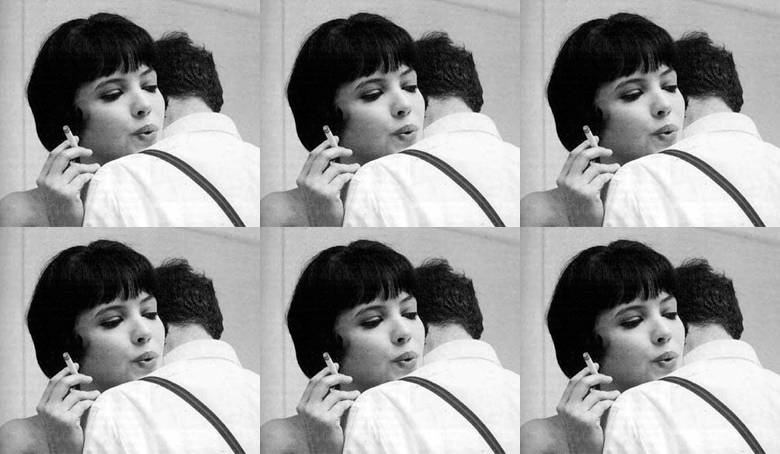
ANNA Karina, all she had to do was run through the Louvre to take my breath away, steal my heart. She didn’t have to dance, but when she did, it was too much and my heart sort of broke a little. She broke Godard’s heart, too. That’s what exes do. And sometimes muses.
Anna K’s a fantasy of mine. Not that sort, but that’ll do, too—the woman is digable, I’m not blind. I do prefer Yoko, in principle, for standing by her man, never leaving. I’d rather have a Yoko, all told. I heart the long haul. Jean-Luc, he may have had Jean Seberg in À bout de souffle, Brigitte Bardot in Le mépris, Chantal Goya in Masculin féminin, but Anna K had this perilous radiance none of them had and, with or without knowing the back story, you get this sense of a lot more at stake, which is how it should be with muses. And Anna K was the proper, righteous, consummate muse. Jean-Luc never stood a chance.
True story taken from Garrison Keillor: “Robert Louis Stevenson was passing by the window of a house one night in France when he looked inside and fell instantly in love with a woman he saw eating dinner with a group of her friends. Stevenson stared at her for what seemed like hours, and then opened the window and leapt inside. The guests were shocked, but Stevenson just bowed and introduced himself. The woman was an American named Fanny Osborne. They fell in love and got married a few years later.”
I saw Vivre sa vie some time back. The resident awe for Anna K’s face, parts of it, if not most of it, like some porno of that visage. Everything begins with a face you can’t escape. Even before the first word is spoken. Even before the first transfer of energies. Even before the parts match. The longing to connect. The urge to pursue. The thundering desire for love. The face reduces you to tongue-tied, sniveling, social deficiency. The face makes you palpitate like a caffeine drip. I have a wobbly theory that none of us are ever sucked in by a fat chance, none of us crush for longshots. There’s no empirical evidence—how can there be? But it hasn’t failed me yet so maybe I’m on to something. Love at first sight is not some wayward phenomenon, it’s the standard. I don’t know you. But I want you. All the more for that. Right.
She was the best kept secret borne from fleeting encounters, remarkable for how the imprint got stickier and stickier with each run-in.
Is that you, my Anna K? Will you run through the Louvre with me? Could you be loved?
Bravado is an also-ran as I think about Anna K and my own first sighting and how some of them still burn holes in my eyes still and I listen to Roky Erickson’s “You Don’t Love Me Yet” and Death Cab for Cutie’s “I Will Possess Your Heart,” one after the other, which is sort of trite but so is trying to imbibe the courage of its convictions—the cock of its bull as it were—but I don’t care and I do so anyway.
Jean-Luc said once that all a movie needs to sell tickets is a girl and a gun—a theory that somehow applies to everything.
A girl and a gun, yeah. Shooting at the walls of heartache. Bang bang.
The author writes about cinema here. Next, "From the Diary of Chow Mo-Wan" by Ricky Torre.
Thursday, December 17, 2009
EITHER/OR ] MM Yu's sari-sari store memories are happy/sad
 The artist bought all of her plastic dolls and toy bikes from Divisoria, which she used to visit a lot when she was younger.
The artist bought all of her plastic dolls and toy bikes from Divisoria, which she used to visit a lot when she was younger.
MM Yu's new works at the Finale Art File continues her fascination for creating bold-colored montages that look either like living memoirs or blownup scrapbooks. Her works often stir nostalgia or spark an urge to rush home and make your own photowall. The effect of her new show is, of course, closer to the former, what with its wealth of plastic toys from childhood, pages from a Chinese calendar, pick-up sticks and play money. Its like a happy perya at first glance, and you remember the first time you won something you like from the sari-sari store pabunot. And then your eyes are led to those paint-covered plastic dolls, and suddenly 'playtime' has become a different game altogether.Jerome Gomez 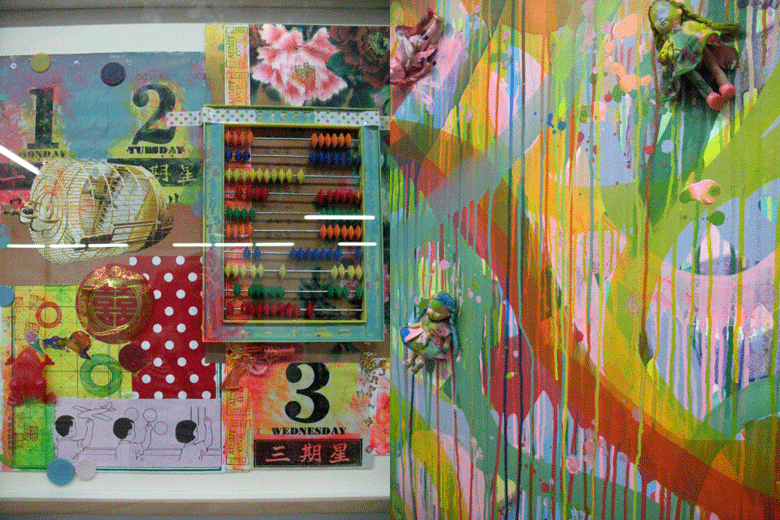 Divi-bought toys mix with Made-in-China trinkets and pages from her childhood: torn strips from books supposed to teach her how to read Chinese, a picture of a bowl of soup (whose taste she never liked) from her mom's recipe book, and various symbols supposed to bring luck.
Divi-bought toys mix with Made-in-China trinkets and pages from her childhood: torn strips from books supposed to teach her how to read Chinese, a picture of a bowl of soup (whose taste she never liked) from her mom's recipe book, and various symbols supposed to bring luck.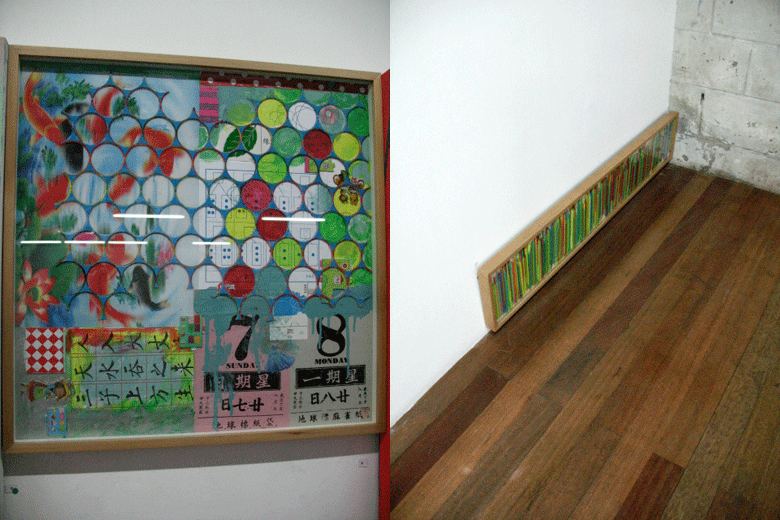 The works, according to the artist, say a lot about our world of mass production and over-consumption, "what we need, what we don't need, what we believe (symbols) will bring to us."
The works, according to the artist, say a lot about our world of mass production and over-consumption, "what we need, what we don't need, what we believe (symbols) will bring to us." 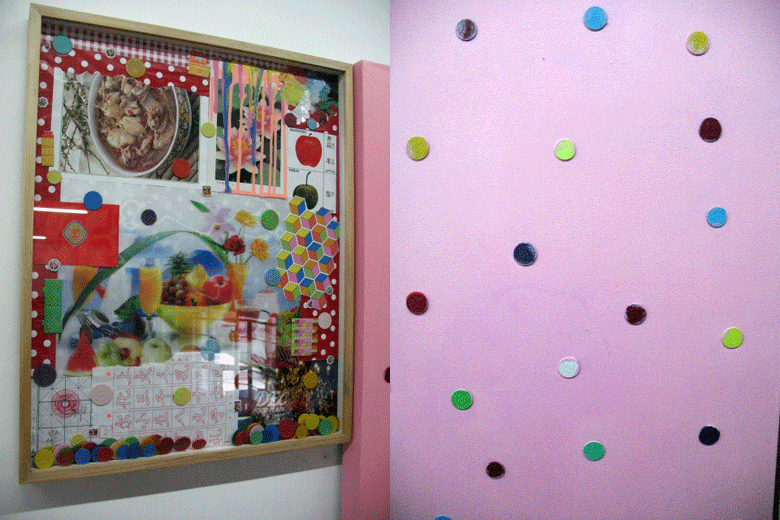 The Philippine peso has gone cute in MM's work (right). She painted the plastic coins and achieved a polka dot pattern against an MMDA pink background.
The Philippine peso has gone cute in MM's work (right). She painted the plastic coins and achieved a polka dot pattern against an MMDA pink background.
Tuesday, December 15, 2009
INDIVISIBLE DIFFERENCES ] Gary Ross Pastrana divides and conquers
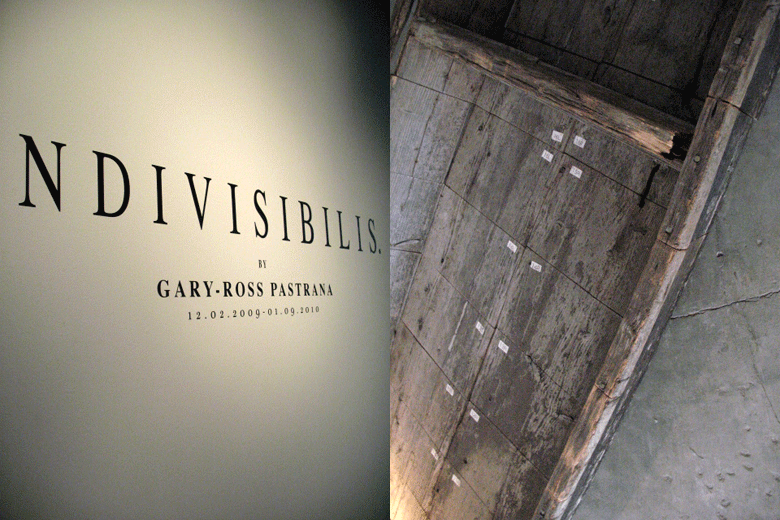
Who ships a boat from Kyoto to Manila? Gary Ross Pastrana.
You'd think he could just easily bring home a parasol or a waving gold cat for a souvenir but no, he wanted a boat. Well, not the Willie Revillame type of boat, because GRP (we'd like to see if calling an artist by his initials will catch on) is not the Willie Revillame type of guy. He's shy and quiet and as the works in his recent show Indivisibilis hint, he knows how to cut through the heart with a little more—no, with a ton more—sensitivity. Okay, that's it for the nonsense Willie comparison. 
The thing is you walk into the sLab space from now up to the 9th of January and you could get your heart broken. It's a lot of things, really. First, it's THAT boat. Its being swept out of its cradling home and now lying on an unsympathetic cement floor. Its the artist transporting that boat. Its the journey its been through and what it meant: from Kyoto where it was cut into parts, put in boxes and then shipped to Korea for the Busan Biennale—to be dismantled again, put in boxes and sent here where the artist reunites with it, in pieces, so he could painstakingly reassemble the boat himself.
And its not just that boat. 
Its those two gold rings. Borrowed from the artist's mother and brought to a goldsmith who was told to melt them and make a miniature sword. The sword was then used to cut a small incision on the artist's arm. The sword then returns to the goldsmith who is instructed to melt the gold again and attempt to recreate the two original rings.
Its the whole silliness of it--the sawing and the splitting into pieces only to be put back together. The sadness of that silliness. And also the loving dedication, the unstinting humility to each object's rebuilding. No matter that in every cutting and splitting, it sheds its flesh a little, possibly getting lighter each time, smaller even, never quite the same.
A waving cat would have been the easy Kyoto memento. But aren't souvenirs supposed to break your heart just a little?
--Jerome Gomez
CONQUISTADOR ] Charlie Cojuangco's art space is ready for battle
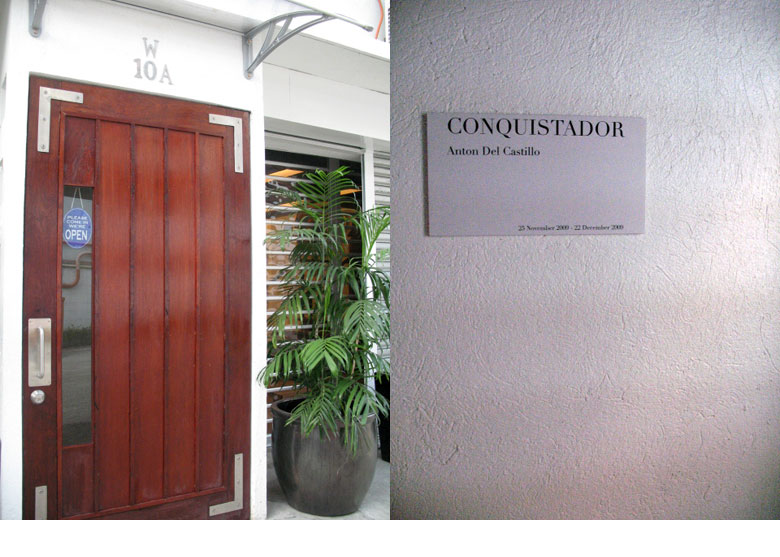

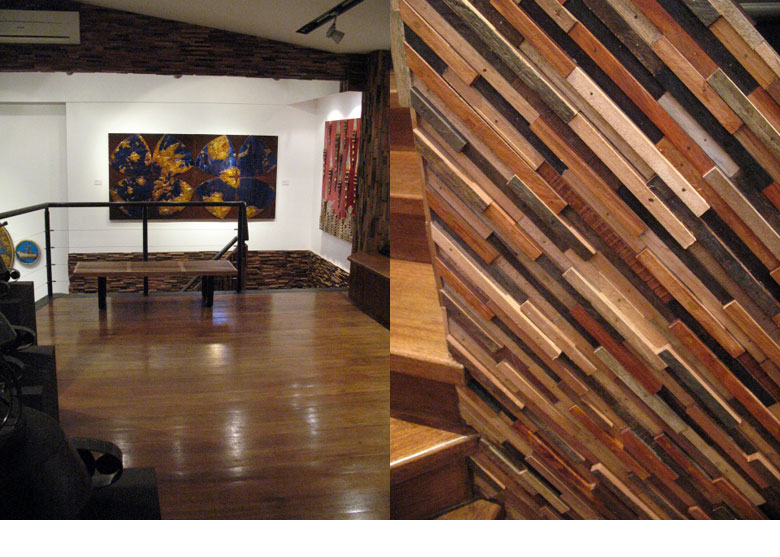
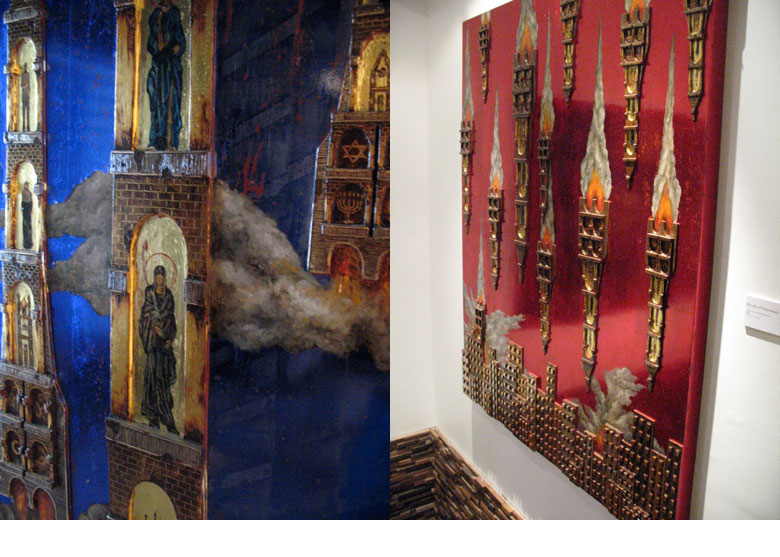
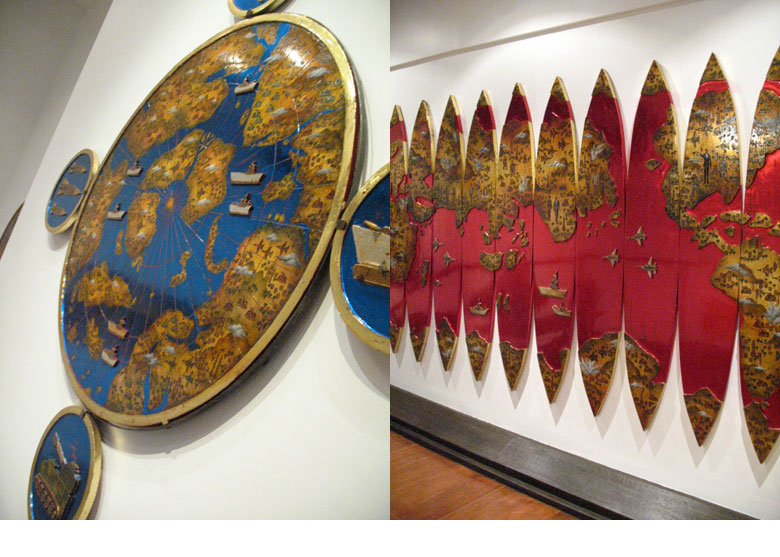
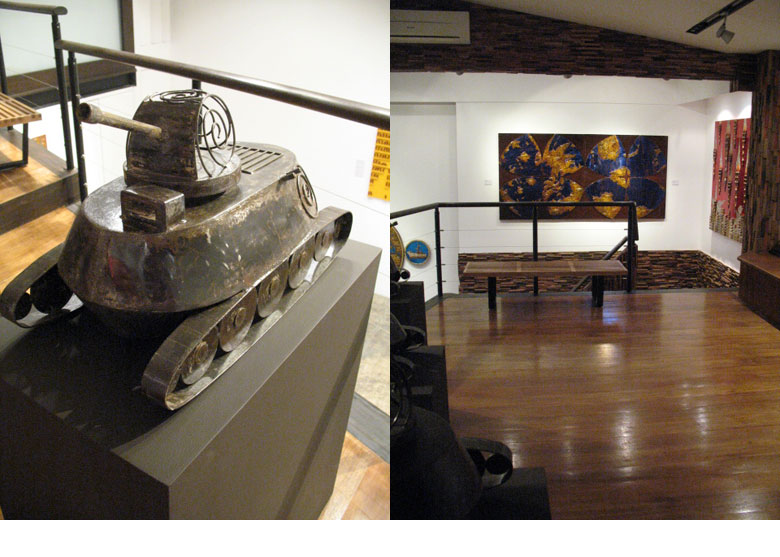
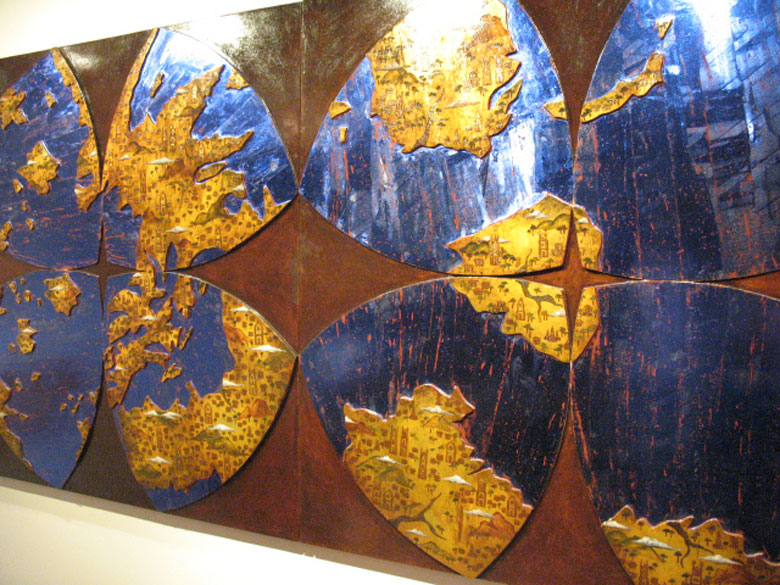
Charlie Cojuangco's much-awaited artspace NOVA (Negros Occidental Visual Arts) Manila officially opens in January 2010 but its introductory show, Anton del Castillo's Conquistador, began last November 25 and will end December 22. NOVA is located at the La Fuerza Compound, Pasong Tamo, Makati,
Monday, December 14, 2009
JUKEBOX HIT ] Don't think twice, it's alright

Don't Think Twice, It's Alright, mixed media on digital print on canvas, 194x153cm., 2009
KAWAYAN DE GUIA echoes the work he presented earlier this year as one of CCP’s 13 Artists Awardees with Katas ng Jeepney, fusing the iconic homegrown vehicle with the near-extinct beer garden fixture, the jukebox. It’s a pity the show ended last weekend at the Drawing Room because y’all had to be there to feel its trippy energy and ‘70s rock & roll bravado. Unless the works pictured here are enough to turn you on. 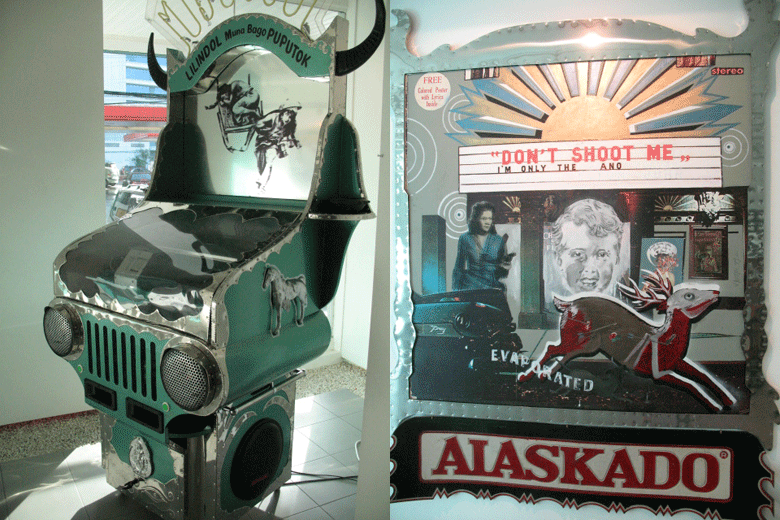
Lilindol Muna Bago Puputok, mixed media, 2009; Alaskado, mixed media on digital print on canvas, 194x143cm, 2009
From Padma Perez’s notes on the show, we learn that Kawayan found out about a number of decaying jukeboxes from a group of Baguio woodcarvers. These men, whose first job in the summer capital (they had come from Ifugao) is to collect the coins from these jukeboxes and deliver them to a certain Mr. Takay, the city’s Jukebox Kingpin, led the artist to Takay’s son. In the ‘90s, when karaoke began to take the rarefied spot of jukeboxes among the local joints, the latter joined the sing-along bandwagon and retired his father’s beloved kitschy music machines.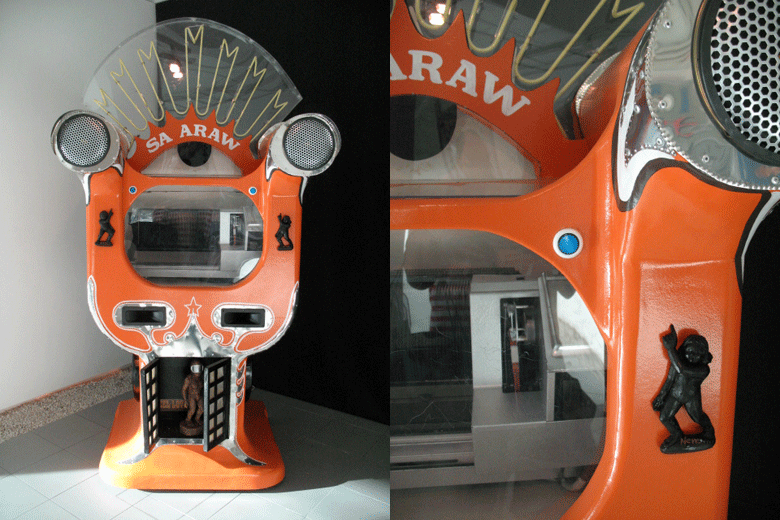
UFO Alien Jeepney, mixed media, 2009; and detail
Having acquired six jukeboxes, the next step for Kawayan now is to find someone who could possibly bring his new babies back to life. Asking around led the artist to one Roger Berdun, a jukebox repairman in Angeles, Pampanga. Berdun made the trip to Baguio, and like a trained surgeon, knew at once what would revive the machines. For days, the guy worked on cleaning, dismantling and rebuilding the machines. Five out of the six were successfully granted their new leases on life, and eventually found their ways to Jun Villalon’s Drawing Room. Not before Kawayan, of course, tinkered with the design, painted on them, layered it with pastiches of Pinoy-born and American-bred nostalgia—and really made them his own. 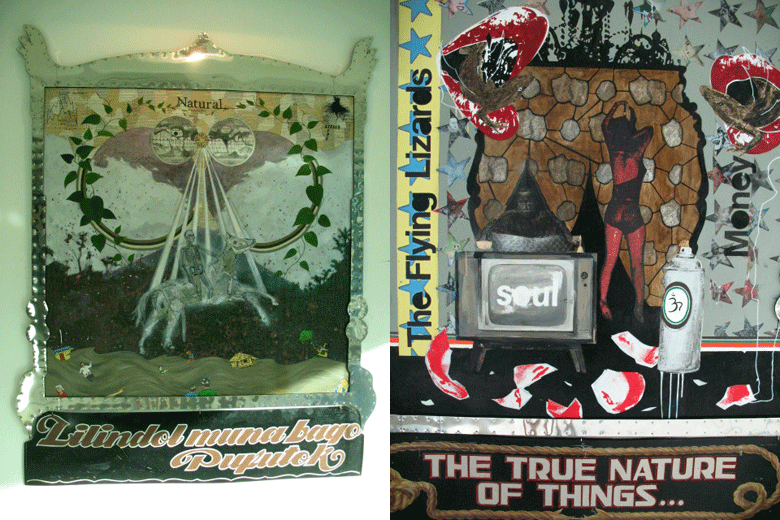
Lilindol Muna Bago Puputok, mixed media on digital print on canvas, 191x139, 2009; The True Nature of Things, detail, mixed media on digital print on canvas, 194x153cm, 2009
State of the Nation, mixed media on digital print on canvas, 191x139cms, 2009; Rock n Roll, mixed media with neon, 2009.
Sunday, December 13, 2009
CARAMOAN X 6 ] Just imagine an Andok's by the beachfront
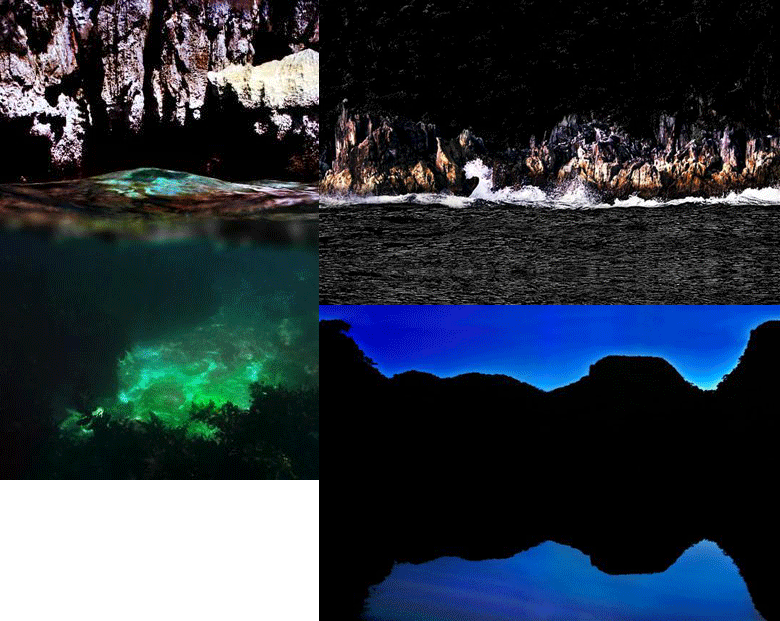
Jun de Leon captures the early morning of Caramoan Island, inspired and reminiscent of a Juvenal Sanso. “Photographs capture a precise moment in a still image. How you take the subject the second you click on your shutter will not be the same the second after. There are numerous moments to be captured in such a breathtaking island.” As long as they preserve its beauty, and not turn it into Boracay, we're all for promoting Caramoan as the next big destination. Jun de Leon, together with Camsur poster boy L-Ray Villafuerte, recently gathered five of the country's most prominent young photographers to capture their own visions of this prized island. The works will be on exhibit beginning this Thursday at Greenbelt 5. Left photo (from left): Jake Versoza, Paolo Pineda, Jo Ann Bitagcol, Jun de Leon, Sara Black and Mark Nicdao.
As long as they preserve its beauty, and not turn it into Boracay, we're all for promoting Caramoan as the next big destination. Jun de Leon, together with Camsur poster boy L-Ray Villafuerte, recently gathered five of the country's most prominent young photographers to capture their own visions of this prized island. The works will be on exhibit beginning this Thursday at Greenbelt 5. Left photo (from left): Jake Versoza, Paolo Pineda, Jo Ann Bitagcol, Jun de Leon, Sara Black and Mark Nicdao.
Jake Versoza uses blacks, grays, and whites in his docu-photo treatment. “I wanted to document the daily lives of the people there because they thrive off nature’s bounty both in land and sea.” How do you capture warmth on film? He answers,” I was there during a strong typhoon but found peace hanging out with the locals. That’s warmth.”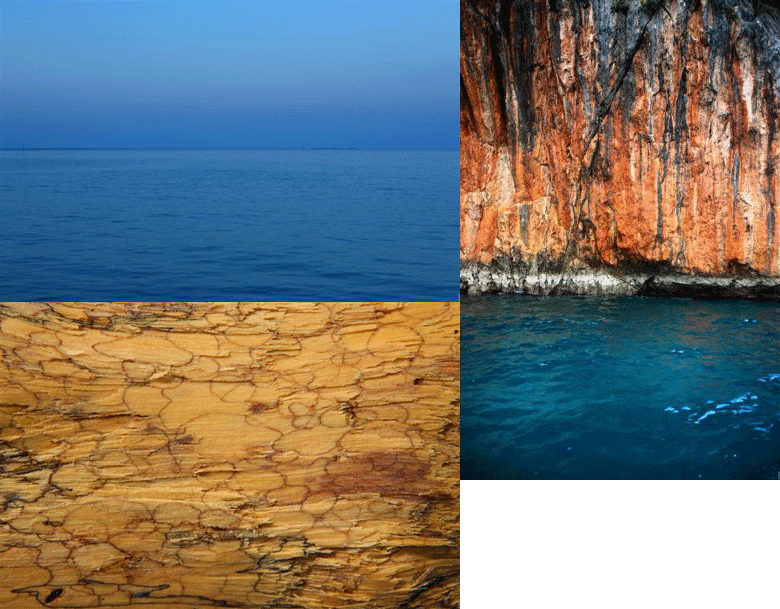 “As a photographer, whenever I go to a place, I always observe how the light there falls and how that affects the color of everything," says Sara Black. Caramoan has its own color palette and I enjoyed tremendously photographing that in its simplicity… the color in the little things. For me, it’s such a sincere joy to appreciate something as miraculous as color.”
“As a photographer, whenever I go to a place, I always observe how the light there falls and how that affects the color of everything," says Sara Black. Caramoan has its own color palette and I enjoyed tremendously photographing that in its simplicity… the color in the little things. For me, it’s such a sincere joy to appreciate something as miraculous as color.”
“It’s the emotion and feeling of the place. It’s a rollercoaster ride. Caramoan has the balance of things you need when you’re on vacation mode. It has a bit of everything you want.” A natural portraitist, Mark Nicdao captures smiles, gleeful eyes, and innocence in his photographs.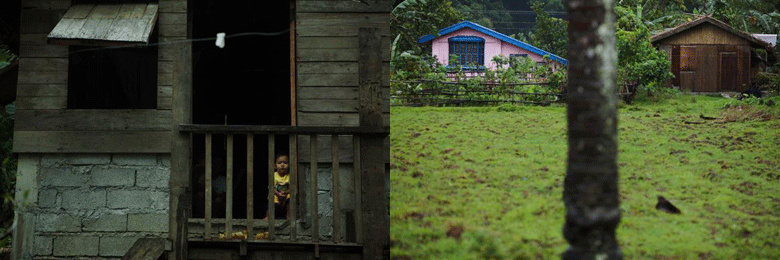 Jo Ann Bitagcol, on the other hand, captures everyday scenes in the island. “Everywhere I go I make it a point to discover its beauty, life, and soul. And I saw all of this in Caramoan,” she says.
Jo Ann Bitagcol, on the other hand, captures everyday scenes in the island. “Everywhere I go I make it a point to discover its beauty, life, and soul. And I saw all of this in Caramoan,” she says.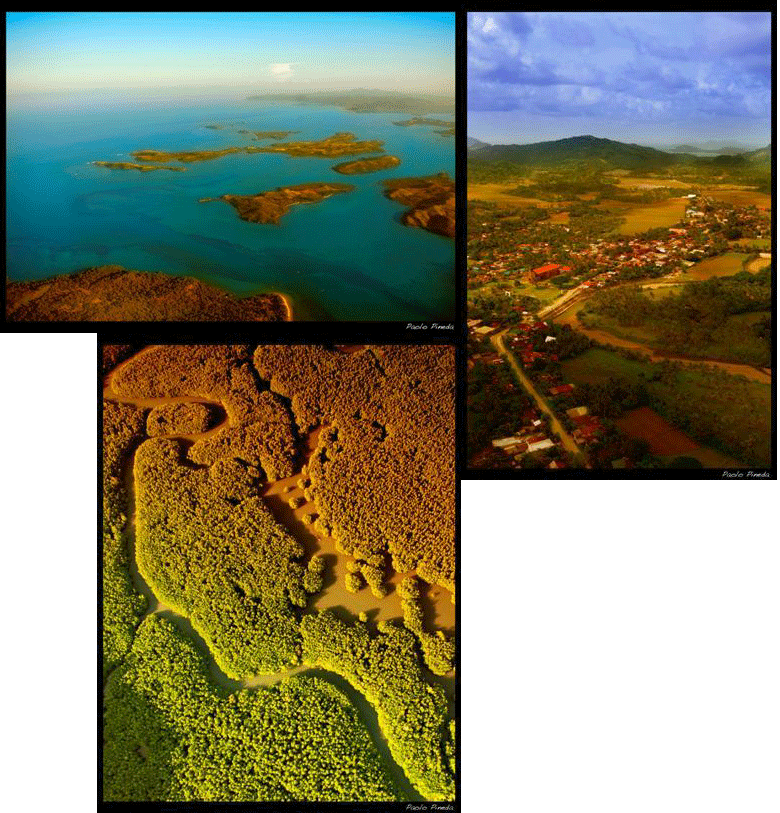 “We rode the chopper going to Caramoan from CamSur," says Paolo Pineda, and seeing it from that vantage point was just surreal. I wanted to capture the island like a classic painting… timeless.”
“We rode the chopper going to Caramoan from CamSur," says Paolo Pineda, and seeing it from that vantage point was just surreal. I wanted to capture the island like a classic painting… timeless.”
THE POLISHED SET ] Last chance to see Reg Yuson's show at Mos today
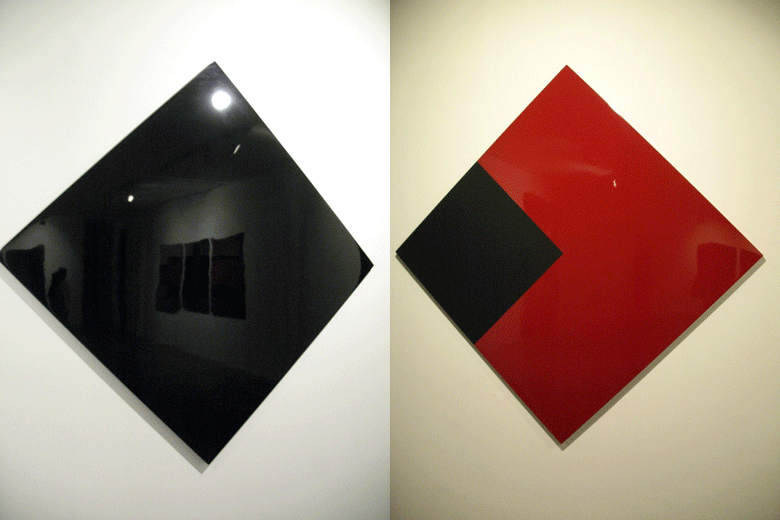
"Wow," the eminent stylist declared as we went inside the empty Mos Gallery last night. "Wow," he repeated. We just came from an art opening at a nearby restaurant and the works there may have been underwhelming for him. But Reg Yuson's works are quite a quiet spectacle.
Ronald Achacoso explains: "Reg Yuson features ten medium sized square panels lacquered with layers of high grade automotive paint that create highly reflective surfaces predominantly rendered in black offset by a few red pieces. These minimalist constructs are hybrid fusions of painting and sculpture, whereas the works themselves are wall bound two dimensional surfaces, it’s execution requires the rigorous process that sculpture entails." 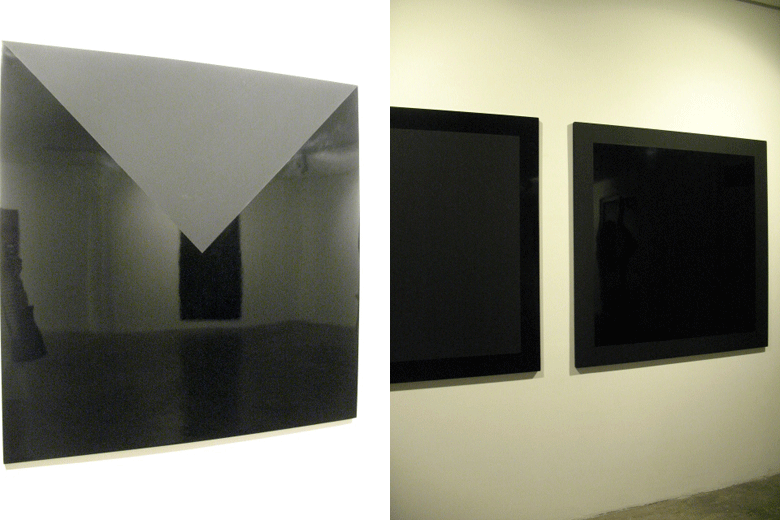
Here's what we think. Choosing only to work on shapes, fiberglass and automative paint, the results are simple, exact, perfect. It says, also, 'This is it, whether you like it or not, I ain't touching it. I'm done.'
We hear ya. We love.
Mos is located at the 3rd Level of Bo Concept at Bonifacio High Street. And for more of Reg Yuson's works, it's those giant public sculptures outside at the High Street grounds.
Saturday, December 12, 2009
KRIP YUSON ON TOKYO ] A Filipino poet's Tokyo
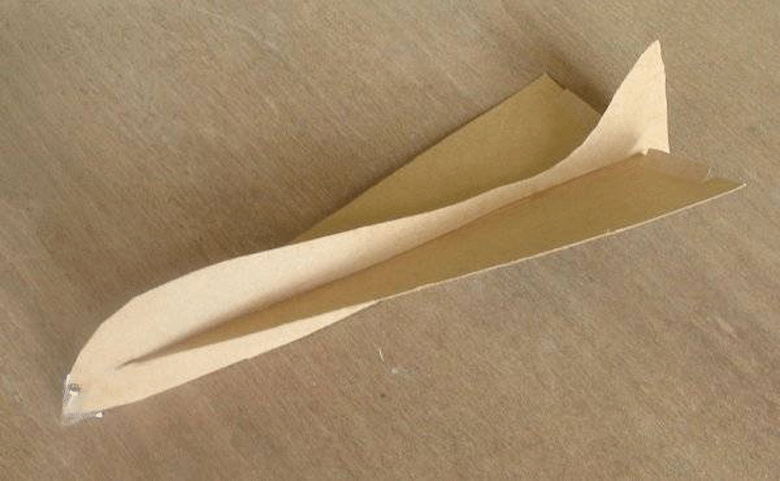
WHEN POETS GATHER, it is all very prim and proper, for starters. When poets get together in Tokyo, the p’s and q’s gain startling modes of, yes, irrelevance. It is a triumph of perspective, one Seoul-based American conferee exulted. Another American, Tokyo-based, quickly took exception.
“Tokyo may make a fine place for any gathering of poets,” he said, “but it isn’t a city for the practicing poet, that is, for the practice of poetry.”
I had known the speaker, Burt Blume, way back since he served as program assistant in Paul Engle’s International Writing Program in Iowa. He had since made his residence in Japan, successfully entering the competitive but materially rewarding field of copywriting.
From his first and only book, Evasions, I recall the lines:
trailing its oriental gown of light,
sifting through thickest air,
a song of stone, a measure of moonlight. . .
You go on.
This evening five years later, gorging on a traditional Japanese epicurean feast that includes four colors of seaweed, he confesses to have temporarily given up on his poetry. There is no time, no mood, the milieu is not right, not right for it here. . . I look down at the quail egg resting on a bed of burgundy seaweed; I “sift… through thickest air.”
After a string of nightcaps at Roppongi’s Hard Rock Café, Burt and his pretty Japanese girl Hiromi drop me off by the Yasukuni Shrine. I’d like to walk the rest of the way home to Virgil’s at Fujimicho, I explain, I need the air after all that Scotch, sake and beer, else the couplets may not come in the morning. We wave goodbye for the night.
I trudge hurriedly on through the shrine, shivering in sixteen-degree weather—a clear fifteen-degree difference from tropic warmth back home. A scream rends the air. To the ear it is a grand chiche, but the eye is startled by an uncommon sight. A young man stands before the inner shrine’s torii, his right arm upraised with clenched fist punching the air. He smartly executes a turnabout, shouts some guttural lines in Japanese, marches forward, turns briskly left, the left and left again. halts, whips about to the right, raises both arms and pierces the night with another scream as if from some swollen gut. He lurches then, circles randomly about, mutters some phrases, and begins to repeat the process.
A madman, I ask myself, or a drunk? Right-wing extremist or midnight fanatic? The translations into guttural English would have to wait for the morning, perhaps trail after the couplets. Consult Virgil our trusty guide on this, I say to myself, and walk on home to end the alien night.
THE NEXT DAY it is Kazuko Shiraishi who charges in as a tsunami or a villanelle. She is recently back from a reading tour up north, this premier lady poet of Japan. Woman poet rather. Le rock star du poesie, exclaims a clipping she holds up proudly to my face as a memento of last year’s visit to Arizona, where she had been widely feted for her poetry cum jazz readings, tight electric pantsuits and reputed friendship with Ferlinghetti and Ginsberg.
She had visited Manila early in the seventies, her reputation as the Queen of Shinjuku preceding her. And in 1979 we had swam and sunned together off Makapuu Pt. in Oahu, where she had regaled me with tales of her “man-wife” back in Tokyo, he who gave excellent massage and shampooed her long black hair with unconventional diligence.
I finally met the man-wife Nobu six years later, that second evening of readings at the Grand Hall. Blowing bravely on a five-foot-long Australian aborigine’s wooden pipe, or didgeridoo, he provided accompaniment to Kazuko’s throaty manifestos on sexual and mythopoetical history. The Shiraishi performance was spellbinding as usual, though not one word made itself understood, to me anyway. The predominantly Japanese audience lapped it all up in grander hush, with most nodding their heads approvingly, appreciatively.
The venerable Kenneth Rexroth, who edited her English-translation volume, Seasons of Sacred Lust, had written of Kazuko in his introduction: “Her poetry can be soft and sweet at times, but mostly it has a slashing rhythm read in what she refers to as her ‘Samurai movie voice.’ Her effect of audiences is spectacular. There is the secret of Shiraishi as a person and poet. She is a thoroughly efficient performer and her poetry projects as does that of very few other poets anywhere. Her parents are Dylan Thomas and Voznesensky. She is also a woman of spectacular beauty.”
At fifty-three, dear amazing Kazuko has preserved her youthful face and figure, and now she undulated onstage in skintight gold sequined pants, using her “Samurai movie voice” to wonderful effect. I imagine that the poem she reads is one from that volume of erotica Rexroth had helped put out. Memory helps ferret out some lines, and in the dim hall the alien city begins to make sense.
At last I’ve settled down on this town
October’s knocked me up
with boredom.
…
My Tokyo
The city that’s almost a womb
Has got me knocking on the gate
…
If I’m poking hard
The hot will in the ashes
It’s so I can burry my city completely
…
My city is
Now far distant
It snuggles close to the stranger’s face
Its head drooping on its concrete neck
(“My Tokyo”)
This is the last of three excerpts we're running from the book Connecting Flights, a travel book, an anthology of poems, stories and essays by 20 Filipino writers on 20 foreign destinations. Edited by Ruel S. De Vera, with poems, stories and essays by Dean Francis Alfar, Butch Dalisay, Lourd De Veyra, Karla Delgado, Chato Garcellano, Ramil Digal Gulle, Jing Hidalgo, Alya Honasan, Marne Kilates, Sarge Lacuesta, Ambeth Ocampo, Charlson Ong, Manuel Quezon III, D.M. Reyes, Sev Sarmenta, Alice M. Sun-Cua, Yvette Tan, Joel Toledo, Krip Yuson and Jessica Zafra.
Thursday, December 10, 2009
MASK MASAYA 'TO! ] A call for portfolios to a photography workshop on portraits and identity
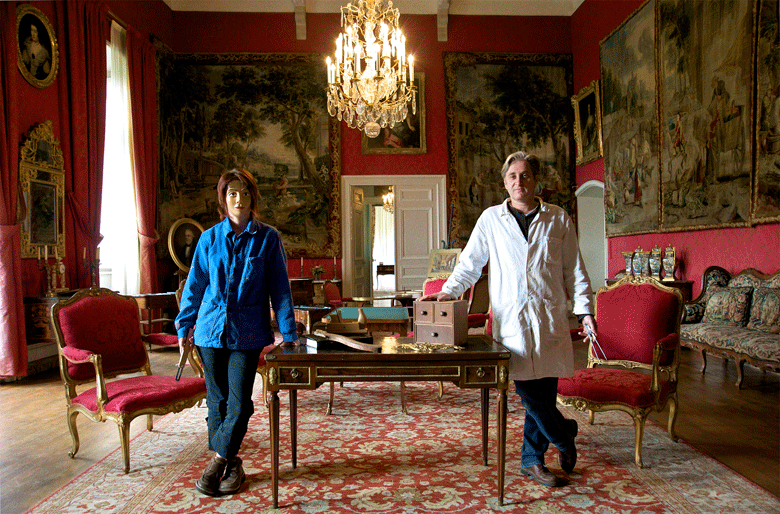
The Apprentice and her Master, 2008
Marc Lathuillière, the French lensman behind “France Face Lost,” will hold a free workshop from 10am to 3pm at Silverlens Gallery on January 30 and February 6 sponsored by Alliance Francaise, followed by an artist’s talk at Silverlens on February 6 at 6pm to introduce his work and artistic approach.
Dealing with French identity and observing France after an extended stay in Asia, Lathuillière questions the stereotypes on which we build our identities with his use of masks. From Provence to Normandy, and from Bordeaux to Metz, more than four hundred people have already let him take their “de-faced” portraits.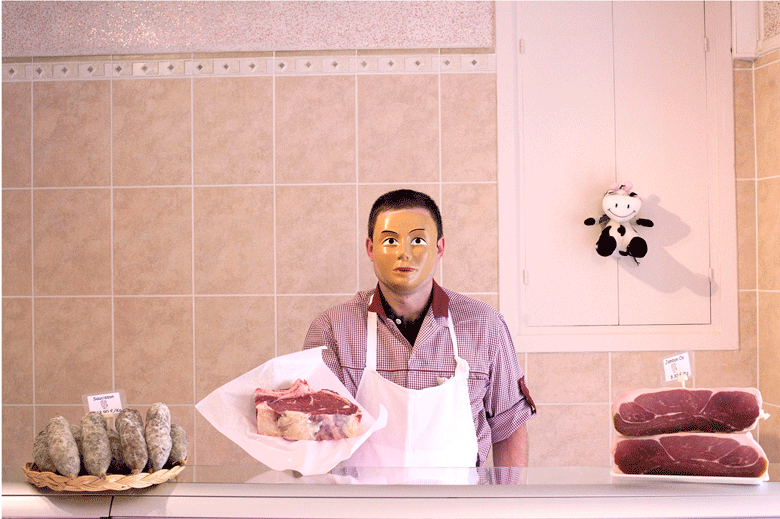
The Quality Meat, 2008
THE WORKSHOP
Day 1, 10am-3pm (5 hrs): From Psychological to Masked Portrait
Participants are invited to bring national costumes (Maria Clara, terno, barong, malong, etc.) and examples of their photographic works, either printed or on a USB flash drive. This session will be spent mostly in the studio.
Day 2, 10am-3pm (5 hrs): From masked to contextual portrait
This second session will be spent mostly outdoors. Participants are invited to bring their own mask. It would be helpful if those who have their own laptops could bring them to the session.
Feb 06, Saturday, 6pm: Artist Talk
“How is it possible to take pictures of the other, whether as a local or a foreigner? What can photography tell us about identity construction? Here are the questions I intend to raise with this Unmasking.”- Marc Lathuillière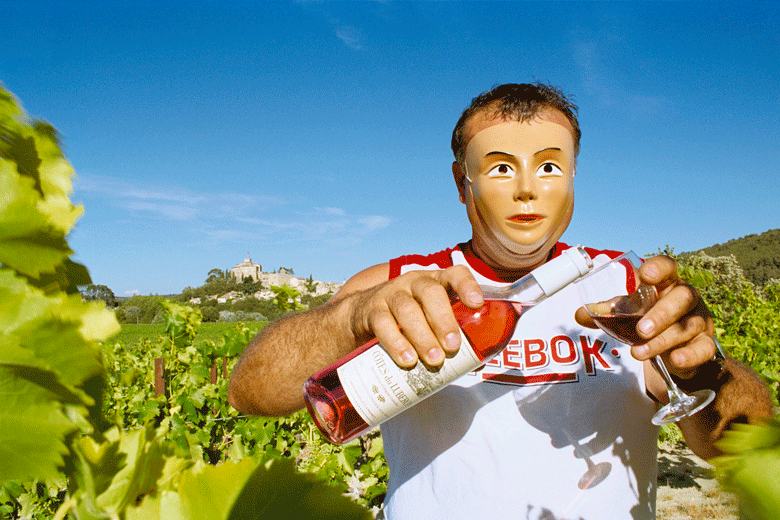
The Provence Winegrower, 2008
APPLICATION PROCESS
Participants to the workshop must first apply for a slot by submitting a portfolio of their works in PDF form along with a CV to Leonore Casuga at manage@silverlensphoto.com. Applicants may also send a cd to Silverlens Gallery, 2nd Floor YMC Building, 2320 Pasong Tamo Extension, Makati City, 1231. Applicants may include their website address in their CV as a supplement, but still need to submit a portfolio in PDF form.
The portfolio should be submitted by December 31. The list of accepted participants will be announced on January 16, 2010.
Marc Lathuillière’s exhibition of photographs “France Face Lost” opens at the Alliance Française Total Gallery on Tuesday, February 2, 2010, with cocktails at 6:30 pm. It will be on exhibit until February 25, 2010.
For inquiries, contact Silverlens Gallery at 2/F YMC Bldg. II, 2320 Pasong Tamo Ext., Makati, 816-0044, 0917-5874011, or manage@silverlensphoto.com. Gallery hours are Monday to Friday 10am–7pm and Saturdays 1–6pm. www.silverlensphoto.com / slab.silverlensphoto.com.
All photographs by Marc Lathuilliere, courtesy of Silverlens Gallery.

